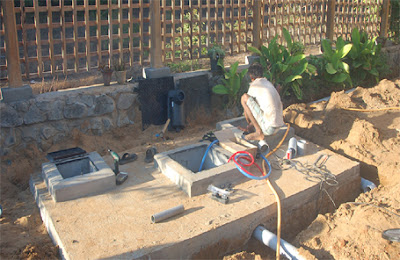Nowadays it is very much important to cover every area within the towns, cities and villages under unified waste water treatment system. Sewage waste originates from domestic residences, small and medium industries and commercial centers.
The SBR sewage treatment plant is a decentralized, effective and compact waste water treatment method. SBR stands for Fibre-Glass Reinforced Plastic. This plant is a system consisting of aeration tank, sludge holding tank, pumping sump, oil and grease chamber, sedimentation tank, control/blower room and horizontal grit chamber. It also has primary, secondary and flow measuring screen chambers. In SBR sewage treatment plant the tank is manufactured in the industry using Fiber Reinforced Plastic.
The SBR sewage treatment plant is quite different from RC extended aeration system. In the pretreatment process, the mechanical coarse screen is provided to eliminate grainy and rough solid material. The sewage is let off from the primary screen. It then streams to wet well from where it is pumped to a secondary screen with the help of raw sewage pump. The fine materials in the sewage are then removed by a fine screen which is present in the secondary screen chamber. Now, the sluggish material like gravel, sand etc is removed by discharging the screened sewage to a grit chamber. Finally, oil and grease chamber eliminates the grease and oil.
Aeration tank consists of diffusers and blowers to provide continuous supply of air. The sewage after the pretreatment process is let off in this tank from where it goes to the secondary clarifies. Here the settlement process takes place. The liquid and sludge is then separated out. The sludge holding tank takes care of the sludge whereas a disinfecting chamber discharges the effluents out to the drain.
The water supplied for domestic purposes is used at homes for various different purposes. The domestic water treatment plant treats the water for drinking or potable purpose. It takes care of the hardness, taste, contamination and odor of the water. The domestic water treatment plant contains activated carbon filter to eliminate harmful organic chemicals, mercury, pesticides and hydrogen sulfide from untreated water. This carbon filter removes many volatile organic chemicals, some pesticides, residual chlorine, radon gas, hydrogen sulfide and mercury. Then distillation removes the heavy metals, salt, nitrates and salt.
The next stage of domestic water treatment plant is reverse osmosis where inorganic minerals, organic contaminants and detergents are removed. Then the water softening eliminates dissolved iron, barium, calcium and radium. Finally, the bacteria and microorganisms are removed by chlorination and UV radiations.
The SBR sewage treatment plant is a decentralized, effective and compact waste water treatment method. SBR stands for Fibre-Glass Reinforced Plastic. This plant is a system consisting of aeration tank, sludge holding tank, pumping sump, oil and grease chamber, sedimentation tank, control/blower room and horizontal grit chamber. It also has primary, secondary and flow measuring screen chambers. In SBR sewage treatment plant the tank is manufactured in the industry using Fiber Reinforced Plastic.
The SBR sewage treatment plant is quite different from RC extended aeration system. In the pretreatment process, the mechanical coarse screen is provided to eliminate grainy and rough solid material. The sewage is let off from the primary screen. It then streams to wet well from where it is pumped to a secondary screen with the help of raw sewage pump. The fine materials in the sewage are then removed by a fine screen which is present in the secondary screen chamber. Now, the sluggish material like gravel, sand etc is removed by discharging the screened sewage to a grit chamber. Finally, oil and grease chamber eliminates the grease and oil.
Aeration tank consists of diffusers and blowers to provide continuous supply of air. The sewage after the pretreatment process is let off in this tank from where it goes to the secondary clarifies. Here the settlement process takes place. The liquid and sludge is then separated out. The sludge holding tank takes care of the sludge whereas a disinfecting chamber discharges the effluents out to the drain.
The water supplied for domestic purposes is used at homes for various different purposes. The domestic water treatment plant treats the water for drinking or potable purpose. It takes care of the hardness, taste, contamination and odor of the water. The domestic water treatment plant contains activated carbon filter to eliminate harmful organic chemicals, mercury, pesticides and hydrogen sulfide from untreated water. This carbon filter removes many volatile organic chemicals, some pesticides, residual chlorine, radon gas, hydrogen sulfide and mercury. Then distillation removes the heavy metals, salt, nitrates and salt.
The next stage of domestic water treatment plant is reverse osmosis where inorganic minerals, organic contaminants and detergents are removed. Then the water softening eliminates dissolved iron, barium, calcium and radium. Finally, the bacteria and microorganisms are removed by chlorination and UV radiations.

No comments:
Post a Comment